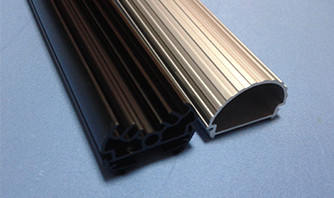1. Bubbles
The air bubble mentioned here refers to the surface air bubble produced in the extrusion process of industrial aluminum profile, not caused by loose casting. Of course, casting looseness may be an incentive, but it is by no means a decisive factor. Poor casting may form a large number of bubbles on the surface of the aluminum profile during the quenching heat treatment after extrusion. The bubbles generated during extrusion will remain intact during quenching and will not develop any further.
Extrusion bubble generation: When there is a large gap between the ingot and the extrusion barrel, the extrusion stage begins, that is, when the casting is upset, if the ingot cannot be deformed in turn from the front to the back, the air in the gap is discharged and squeezed Outside the pressing cylinder, aluminum profiles may form compressed bubbles between the wall of the cylinder and the surface of the ingot. The pressure in the bubbles increases with the increase of the pressing force. At the same time, friction occurs between the ingot and the wall of the extrusion cylinder, or between the plastic deformation zone and the dead zone of the compression cone, resulting in a shear deformation, and tensile stress is generated on the surface of the ingot or the outer circumference of the compression deformation cone, which may form an instant micro crack. When compressed bubbles under great pressure meet such tiny cracks, the compressed bubbles may break through the shell and intrude into the micro-cracks.
When compressed bubbles under great pressure meet such tiny cracks, the compressed bubbles may break through the shell and intrude into the micro-cracks. After extrusion, it is elongated and deformed to form bubbles on the surface of industrial aluminum profiles. When the compressed bubble bursts, sometimes the sound of "blasting" can be heard. The larger the gap between the ingot and the extrusion cylinder, the more serious the extrusion cylinder and the extrusion pad wear, the faster the upsetting speed, or the more volatile gas generated by the lubricating oil being carried into the extrusion cylinder, formed during extrusion The greater the probability of surface bubbles. Such bubbles sometimes change from large to small along the squeezing direction and are distributed linearly in series. Reduce the gap between the ingot, the extrusion pad, and the cylinder wall, reduce the amount of air remaining in the extrusion cylinder; prevent the pollution of the extrusion cylinder by the lubricant; in particular, implement the gradient heating along the length of the ingot, and properly It can slow down the upsetting speed at the beginning of the extrusion stage, realize the upsetting deformation of the ingot from front to back, and discharge the air out of the extrusion cylinder, which can effectively avoid or reduce the generation of extrusion bubbles.

Extrusion Aluminum Enclosure
In addition, when the split die is extruded, extrusion bubbles will be generated on the next profile at the junction of the Extrusion Aluminum Enclosure. Such bubbles generally occur on the upper surface of the aluminum profile. Because the residual material separation shears fall down from the top, the residual material exposed outside the mold is removed and dropped, and the excess metal connected to the profile in the split die cannot be removed, and space is left on the upper part of the mold hole. When squeezing the next profile, the upsetting ingot will seal and pressurize the gas in the upper space in the die hole, thus leaving bubbles on the upper surface of the profile head. Of course, if the separation shear enters from the side, the aluminum profile will leave bubbles on the side where the separation shear enters. The slow upsetting speed of such bubbles can be slightly reduced, but it is difficult to eliminate them. However, such bubbles are generally not too serious and only appear on the head. After the aluminum profile is cut off, it will not hinder the use. It has an impact on the yield, but it has little effect.
2. Peel
If the above-mentioned bubbles break during the extrusion process, the surface metal and the inner metal are separated and become peeling. After peeling off the peel, the skin is smooth and has a metallic luster.
In addition to air bubbles caused by peeling, the inside of the extrusion cylinder is contaminated, the wall of the extrusion cylinder is seriously worn, there is too much residual metal in the cylinder, and the cleaning is not clean. The residual metal is brought out on the surface of the new industrial aluminum profile during extrusion so that The aluminum profile is peeling. However, the skin is contaminated with oil stains and loses its metallic luster; or it is not stained with oil, but the new and old metals cannot be closely combined, which destroys the continuity of the metal and damages the finish of the subcutaneous surface. We are a custom electronic radiator supplier, if you are interested in our products, please feel free to contact us.